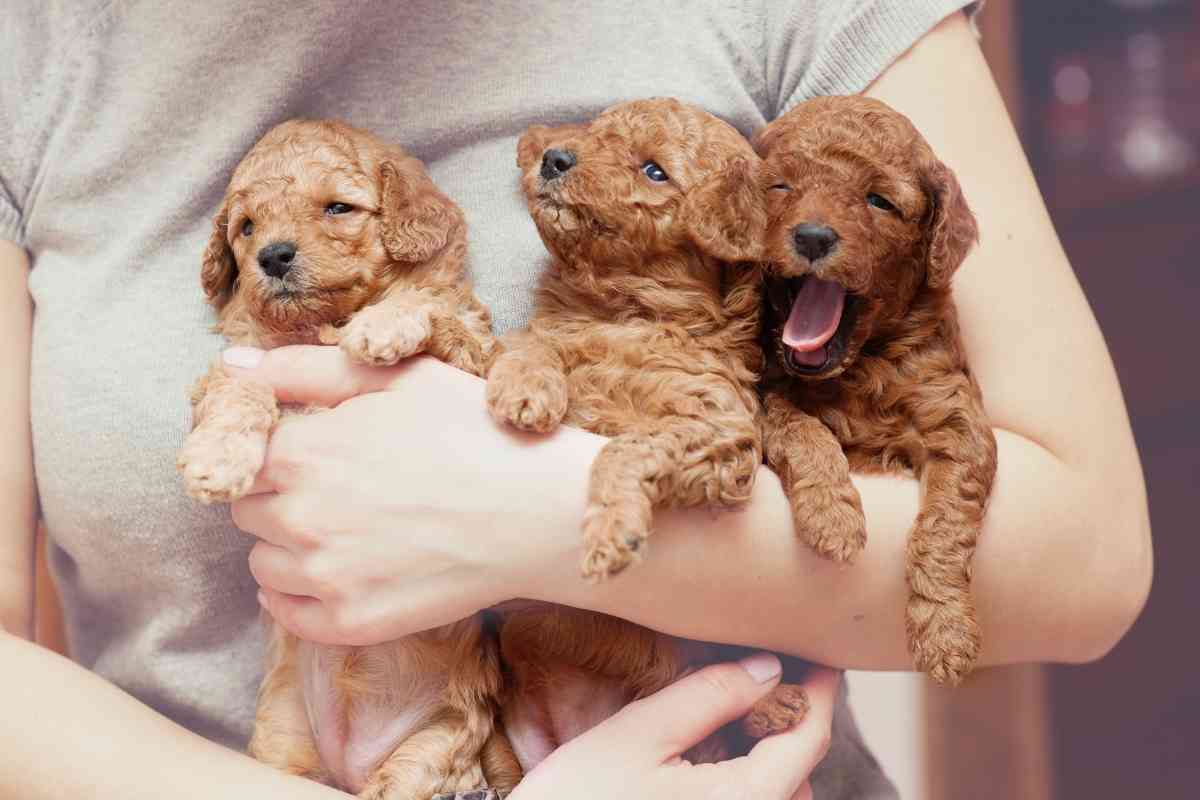Do Poodle Puppies Shed? 4 Steps To Prevent Poodle Shedding
Poodles are renowned for their loveable personalities, playful nature, and desired curly coats. However, the real worry is Poodle puppies shed. Potential dog parents who want to expand their family with a furry friend worry about whether the dog may aggravate their allergies.

Do Poodle puppies shed?
Poodle puppies shed, but they do so less than other dogs because of their single, dense, coiled undercoat, making them hypoallergenic. Double-coated dogs’ undercoats shed heavily during the seasons in addition to their normal shedding.
Take your dog to the veterinarian if you see excessive shedding, which may indicate a health problem. Pet allergy sufferers may find Poodles a good option, but you should always spend significant time with Poodles in their homes before acquiring one.
Here is everything you need to know about Poodle puppies shedding. You will find details about when to expect the puppies to shed, how to deal with the shedding, and other potential reasons that could make the Poodles shed. However, getting further advice from your vet is still recommended because each pup is different, and what works for one may not work for the other.
Do Poodles Shed?
Contrary to the prevalent belief that Poodles are non-shedders, Poodles experience shedding since all dog breeds are shed. The amount of hair Poodles shed differentiates them from the famous high shedders.
Poodles lose little hair—the reduced shedding results from their single, dense, curled undercoat. The undercoats of double-coated dogs undergo substantial seasonal shedding adding to regular shedding.
If you’re concerned about excessive shedding, it’s good to visit a vet for further check up. There are several medical conditions that may lead to excessive shedding. A vet will be able to identify the reason your Poodle is shedding too much.
When Do Poodle Puppies Shed?
Poodles will shed in the first three to nine months of their life. Poodle puppies possess rapid hair growth cycles. The shedding in Poodles occurs because old hair must be removed to create room for newly grown hair.
Typically, standard Poodles lose their puppy coats between the ages of nine and sixteen, whereas the other two Poodles do so at eight to ten months.
Other Reasons Why Poodles May Shed
Poodles, like humans, are of the same breed, but each is unique. Your friend’s Poodle may shed significantly more than yours, but this is no cause for panic. Ensure you enquire from the breeder at what age and how much their parents shed.
Remember that larger dogs naturally shed more fur since they have a larger coat surface.
If you detect a substantial spike in the amount of hair your Poodle is shedding, you should have them examined by a veterinarian. A specialist should discover the underlying cause.
Some of the reasons why your goodest boy may be shedding more fur than usual include:
Allergies
Check your Poodle’s sensitivity to shampoos, chemicals, and the food they eat in everything they use. If your pawed buddy is allergic to some products they are using, the excess hair fall out will come with a pungent stench, open wounds, and dry or itchy skin.

Red Mange
Demodicosis, often known as red or demodectic mange, is a skin condition brought on by a tiny, imperceptible mite. This mite resides deep into the hair’s root.
Demodex mites are in modest numbers in all healthy dogs, but in some, they overgrow. When they overgrow, they cause the dog’s hair to shed in excess leaving behind bald spots.
Stress
Poodles can tell when their parents are stressed, which also affects them. The stress can come from when your family or house undergoes a major upheaval, your dog’s diet or lifestyle changes, or when you relocate their kennel.
Epinephrine, sometimes referred to as adrenaline, released when your dog is under stress, causes the hair to fall out. Although the cause of this is unknown, you can be confident that their fur will fall off if your best buddy is stressed.
Pregnancy
Changes in a mother’s hormones may lead to more hair loss. Your pup may also have deficient calcium and minerals needed for a healthy Poodle coat during pregnancy. This behavior should disappear and return to normal once the litter is born and her hormones have settled.
Cushing’s disease
Older Poodles are susceptible to Cushing’s disease. When your aging best buddy has Cushing’s disease, you will notice hair loss along the back, tail, and hind legs.
Except for the Poodle’s head and feet, the coat thins, or the hair falls ultimately. The most prevalent symptom of Cushing’s syndrome in dogs is muscular weakness.
Precautions To Take When Your Poodle Is Shedding
Poodles’ hair follicles have a longer active development period than regular fur follicles; hence, each hair strand will continue to develop for a long time before shedding. The Poodle’s curly coat and coarse texture prevent fur from shedding, increasing the likelihood that shed hair will be entangled.
Since the coat cannot fall out naturally, you will need to remove the Poodle’s hair manually. Failure to ensure you remove the fur will be very detrimental to your dog’s health.
Here’s how to get it done
brush Your Pet
Brushing solves the issue of the shed hair tangling with the growing hair. To be safe,
Renowned veterinarians recommend writing down a weekly brushing schedule you will commit to. To familiarize your puppy with brushing, you should begin when they are small.
Remove most of the shed hair with a
Bather your pet regularly
Bathing helps remove dirt and fallen fur from your dog’s coat. In addition, you can use shampoos designed for dog skin and fur to keep your dog’s smooth, curled, and shiny coat. Alternatively, you can opt to use your shampoos but ensure you read the ingredients first to ascertain the product does not have any toxic chemicals.
Give your dog frequent baths at least once every two weeks, but you can bathe your puppy more often if their coat is shedding more and if you have time. Use warm water instead of cold water since it will enlarge your dog’s follicles, hastening their hair loss.
Diet
Water intake and a nutritious diet are essential to your dog, just like they are to you. To promote healthy skin and hair, you should consume a diet with many vitamins and minerals and ensure you reciprocate the same to your Poodle.
Dietary deficits can increase the amount of shedding in dogs. To maintain your dog’s health, ensure that their food contains adequate vitamins.
The best food to offer a puppy is dog food. Consult a veterinarian if you are uncertain about the ideal dog food to avoid giving your pup food that is unsafe for them.
Supplements
Dogs are like humans, which explains why the two get along. In the same way, you need supplements, so does your dog. Supplements might help provide your dog with the necessary nutrition that adds to what they get from the food they eat. Your Poodle requires the necessary oils to maintain a healthy coat.